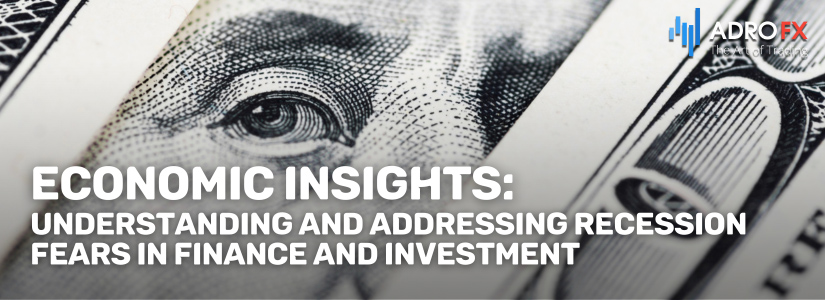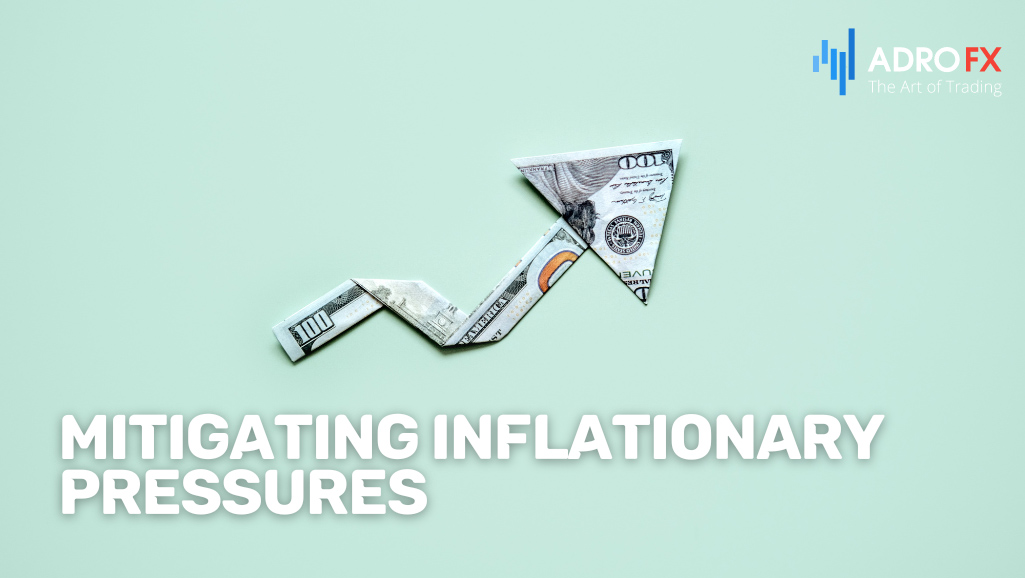Economic Insights: Understanding and Addressing Recession Fears in Finance and Investment

In the intricate world of finance and investment, few phenomena evoke as much trepidation and concern as the specter of a looming recession. Recession fears, whether whispered anxiously in the corridors of Wall Street or discussed with furrowed brows in boardrooms worldwide, have a profound impact on market sentiment, investment decisions, and economic policymaking. Understanding the intricacies of recessionary trends is not merely an academic pursuit; it's a critical imperative for anyone with a stake in the financial landscape.
As such, this article embarks on a journey to dissect and demystify recession fears, offering insights and analysis tailored for finance and investment enthusiasts. By delving into the nuances of what defines a recession, examining its telltale signs, and exploring its implications for investors and financial markets, we aim to equip readers with the knowledge and understanding necessary to navigate these uncertain times with confidence and foresight.
Defining Recession
At its core, a recession represents a period of economic contraction characterized by a sustained decline in economic activity across various sectors of the economy. While the precise definition may vary among economists and policymakers, certain key characteristics distinguish a recession from mere fluctuations in economic growth.
One defining feature of a recession is a decline in gross domestic product (GDP) over two consecutive quarters, signaling a contraction in overall economic output. However, GDP alone does not encapsulate the full extent of economic downturns. Recessions are also marked by declines in consumer spending, business investments, industrial production, and employment levels, creating a ripple effect that permeates through the fabric of the economy.
For investors and financial markets, identifying recessionary periods is of paramount importance. Recessionary environments bring heightened uncertainty, increased market volatility, and potential disruptions to investment portfolios. Understanding the warning signs and economic indicators that precede recessions allows investors to anticipate market movements, adjust their investment strategies, and mitigate potential risks.
In the following sections, we will delve deeper into the intricacies of recessionary trends, exploring the role of central banks, global economic interconnections, financial market trends, and expert insights in shaping our understanding of recession fears and their impact on finance and investment. Through this exploration, we aim to provide readers with the knowledge and insights needed to navigate the complexities of recessionary environments with confidence and resilience.

Key Indicators of Economic Health
Understanding the pulse of the economy requires a keen eye on several key indicators that serve as barometers of economic health. Among these, GDP growth stands as a cornerstone, offering insights into the overall pace of economic expansion or contraction. A robust GDP growth rate indicates a thriving economy, while a decline suggests potential recessionary pressures. Similarly, consumer spending, often dubbed as the engine of economic growth, provides a snapshot of consumer confidence and purchasing power. High levels of consumer spending signal optimism and economic vitality, whereas a downturn in spending can signal caution and impending economic challenges.
Unemployment rates also play a pivotal role in assessing economic health, serving as a gauge of labor market conditions and overall employment stability. Low unemployment rates typically correlate with a strong economy, reflecting robust job creation and economic opportunities. Conversely, rising unemployment rates can signal economic distress, impacting consumer sentiment and spending patterns.
These key indicators of economic health not only reflect the current state of the economy but also influence investment decisions profoundly. Investors scrutinize these indicators to gauge the direction of the economy and adjust their investment strategies accordingly. For instance, strong GDP growth and low unemployment rates may prompt investors to adopt a bullish stance, increasing their exposure to equities and riskier assets. Conversely, signs of economic weakness, such as sluggish consumer spending or rising unemployment, may lead investors to adopt a more cautious approach, favoring defensive assets and safe-haven investments.
The Role of Central Banks
Central banks, particularly the Federal Reserve in the United States, wield considerable influence in managing economic stability, especially during periods of recession. One of the primary tools at their disposal is monetary policy, which involves adjusting interest rates to regulate economic activity. During times of economic downturn, central banks may opt to lower interest rates to stimulate borrowing and investment, thereby spurring economic growth. Lower interest rates make borrowing cheaper, encouraging businesses and consumers to invest and spend, respectively, thereby bolstering economic activity.
Conversely, during periods of inflationary pressure or economic overheating, central banks may raise interest rates to cool down the economy and prevent excessive inflation. Higher interest rates make borrowing more expensive, curbing borrowing and spending, and dampening inflationary pressures.
The impact of central bank policies, particularly interest rate adjustments, reverberates across financial markets and investor sentiment. Lower interest rates typically boost stock prices, as investors seek higher returns in riskier assets amid low borrowing costs. Conversely, higher interest rates may dampen stock market returns, as borrowing becomes more expensive, potentially leading to a shift towards safer assets.
Furthermore, central bank policies influence investor sentiment and market expectations. Forward guidance from central bank officials regarding future policy actions can shape market perceptions, influencing investment decisions and asset prices. As such, central banks play a crucial role in shaping the trajectory of financial markets and navigating economic uncertainties during periods of recession.
Global Economic Interconnections
The modern economy is characterized by interconnectedness on a global scale, where developments in one region can have far-reaching implications for economies around the world. International trade serves as a linchpin of this interconnectedness, facilitating the exchange of goods, services, and capital across borders. Fluctuations in global trade dynamics, such as changes in tariffs or trade agreements, can impact economic conditions in individual countries and regions, influencing factors like export-import balances and GDP growth.
Commodity prices represent another crucial aspect of global economic interconnections, with commodities like oil, metals, and agricultural products serving as essential inputs in various industries. Shifts in commodity prices can affect inflation rates, production costs, and consumer prices, thereby influencing economic conditions and investment opportunities. For instance, a spike in oil prices can lead to higher transportation costs and inflationary pressures, impacting consumer spending and business investment decisions.
Foreign investments also play a significant role in shaping domestic economic landscapes, as capital flows across borders in search of attractive investment opportunities. Foreign direct investment (FDI) and portfolio investments can inject capital, technology, and expertise into domestic economies, stimulating economic growth and development. Conversely, changes in foreign investment flows can impact currency exchange rates, asset prices, and capital markets, influencing investment opportunities and market dynamics.
Understanding these global economic interconnections is paramount for investors and policymakers alike, as developments in one part of the world can have ripple effects across financial markets and economic landscapes. Analyzing global trade patterns, commodity price trends, and foreign investment flows provides insights into broader economic trends and helps identify investment opportunities in a globalized marketplace.

Financial Market Trends
Financial markets serve as barometers of investor sentiment and economic expectations, reflecting the collective wisdom of market participants. Analyzing trends in financial markets, including stock market performance and treasury yield curves, offers valuable insights into prevailing market sentiment and economic outlook.
Stock market performance is often viewed as a leading indicator of economic health, with rising stock prices signaling optimism about future economic prospects, and declining prices indicating apprehension or uncertainty. Bullish stock market trends typically coincide with periods of economic expansion, reflecting robust corporate earnings, business confidence, and investor optimism. Conversely, bearish market trends may signal concerns about economic growth, corporate profitability, or geopolitical risks, prompting investors to adopt a more defensive stance.
The treasury yield curve, which charts the yields of US government bonds across different maturities, provides additional insights into economic expectations and interest rate outlook. A normal, upward-sloping yield curve suggests expectations of positive economic growth and inflation, while an inverted curve can signal recession fears or expectations of monetary policy tightening. Changes in the yield curve shape investor perceptions about future interest rate movements, influencing borrowing costs, investment decisions, and asset allocation strategies.
By monitoring trends in financial markets, investors can gain valuable insights into market sentiment and economic expectations, enabling them to make informed investment decisions and navigate volatile market conditions effectively.
Expert Insights and Forecasts
Chief economists and investment officers play a crucial role in providing expert insights into the current economic landscape and forecasting future trends. Drawing on comprehensive data and analysis, these professionals offer valuable perspectives on key economic indicators, market trends, and investment opportunities. Their analysis helps investors navigate uncertainty and make informed decisions by providing clarity amid complex and dynamic market conditions.
Chief economists leverage their expertise to interpret economic data and identify emerging trends, providing insights into factors influencing economic growth, inflation, and employment. Investment officers analyze market dynamics and investment opportunities across asset classes, offering strategies for portfolio diversification and risk management. By synthesizing economic research, market analysis, and industry trends, these experts provide actionable recommendations tailored to investors' objectives and risk profiles.
Access to expert insights and forecasts enables investors to stay abreast of evolving market trends and adjust their investment strategies accordingly. Whether assessing market sentiment, evaluating sector-specific opportunities, or hedging against potential risks, investors can leverage expert analysis to make well-informed decisions that align with their investment goals and risk tolerance.

Mitigating Inflationary Pressures
Rising prices and inflationary pressures pose significant challenges to consumer spending and business investments, necessitating strategies to mitigate their adverse effects. For consumers, inflation erodes purchasing power, reducing disposable income and limiting spending on goods and services. To counteract these effects, individuals may adjust their consumption patterns, prioritize essential purchases, or seek higher-paying employment opportunities.
Businesses also face challenges from inflation, as higher input costs squeeze profit margins and impact pricing strategies. To mitigate inflationary pressures, companies may implement cost-saving measures, optimize supply chain management, or pass on higher costs to consumers through price adjustments. Additionally, businesses may invest in productivity-enhancing technologies or innovation to improve efficiency and maintain competitiveness in inflationary environments.
Inflationary pressures can also impact financial markets and investment portfolios, influencing asset prices, interest rates, and investment returns. Fixed-income investments, such as bonds, may experience diminished purchasing power in inflationary environments, prompting investors to seek inflation-protected securities or inflation-hedging strategies. Equity investments may benefit from rising prices in certain sectors, such as commodities or inflation-sensitive industries, while other sectors may face headwinds from higher input costs or reduced consumer spending.
By adopting proactive measures to mitigate inflationary pressures, individuals and businesses can navigate challenging economic environments and preserve financial stability. Diversifying investment portfolios, hedging against inflation risks, and pursuing cost-saving initiatives are essential strategies for managing the impact of rising prices and inflation on wealth accumulation and economic growth.
Government Policies and Interventions
Government policies, including fiscal stimulus measures and monetary interventions, play a crucial role in addressing recessionary trends and stabilizing financial markets. During periods of economic downturns or recession fears, policymakers may implement fiscal stimulus packages to stimulate aggregate demand, boost consumer spending, and support business investments. Fiscal measures such as tax cuts, infrastructure spending, and unemployment benefits aim to spur economic activity and create jobs, providing a counterbalance to contractionary forces in the economy.
Monetary interventions by central banks, such as the Federal Reserve, also play a vital role in managing economic stability and market confidence. Central banks may adjust interest rates, implement quantitative easing programs, or provide liquidity support to financial institutions to ensure the smooth functioning of credit markets and maintain liquidity conditions. These interventions influence borrowing costs, investment decisions, and asset prices, shaping investor sentiment and market dynamics.
The effectiveness of government policies and interventions in addressing recessionary trends depends on various factors, including the severity of the economic downturn, the timeliness of policy implementation, and the coordination between fiscal and monetary authorities. Successful policy measures can restore investor confidence, stabilize financial markets, and pave the way for economic recovery. Conversely, ineffective or delayed policy responses may exacerbate recessionary pressures, prolonging economic downturns and dampening market sentiment.
By monitoring government policies and interventions, investors can gain insights into policymakers' responses to economic challenges and anticipate their implications for financial markets and investment portfolios. Understanding the dynamics of fiscal and monetary policy frameworks enables investors to adjust their investment strategies accordingly and position themselves to capitalize on emerging opportunities amid changing market conditions.
Conclusion
In conclusion, this article has provided an in-depth analysis of recession fears and their implications for finance and investment enthusiasts. We began by defining a recession and highlighting its key characteristics, emphasizing the significance of identifying recessionary periods for investors and financial markets. Throughout the discussion, we explored various factors influencing economic health, including leading indicators such as GDP growth, consumer spending, and unemployment rates.
Central to economic stability are the roles of central banks, particularly the Federal Reserve, in managing monetary policy and stabilizing financial markets during periods of recession. We also examined the interconnected nature of the global economy and its influence on domestic markets, as well as trends in financial markets such as stock performance and treasury yield curves.
Insights from chief economists and investment officers provided valuable perspectives on the current economic landscape and future expectations, guiding investors in navigating uncertainty and making informed decisions. Furthermore, strategies for mitigating inflationary pressures and the impact of government policies and interventions on recessionary trends were discussed.
In summary, understanding recessionary trends is essential for finance and investment enthusiasts to anticipate economic shifts and make sound investment decisions. By staying informed about key economic indicators, monitoring financial market trends, and leveraging expert insights, investors can navigate economic uncertainty effectively and capitalize on investment opportunities amid changing market conditions.
About AdroFx
Established in 2018, AdroFx is known for its high technology and its ability to deliver high-quality brokerage services in more than 200 countries around the world. AdroFx makes every effort to keep its customers satisfied and to meet all the trading needs of any trader. With the five types of trading accounts, we have all it takes to fit any traders` needs and styles. The company provides access to 115+ trading instruments, including currencies, metals, stocks, and cryptocurrencies, which make it possible to make the most out of trading on the financial markets. Considering all the above, AdroFx is the perfect variant for anyone who doesn't settle for less than the best.










